Ethereum accumulation has surged: addresses labeled as “accumulating” doubled ETH holdings from ~13M to ~28M since June 2025, tightening supply. Rumors that Grayscale may stake part of its 1.5M ETH could lock more tokens, reducing circulating ETH and increasing supply-side pressure on price.
-
Accumulating addresses doubled holdings to ~28M ETH since June 2025.
-
Grayscale reportedly moved 40,000+ ETH and may stake a portion of its ~1.5M ETH ETF holdings.
-
Daily price action cooled: ETH near $4,524; RSI and MACD show neutral momentum.
Ethereum accumulation surges: ETH held by accumulating addresses doubles; Grayscale staking rumors tighten supply — read the latest analysis and market impact.
What is driving the recent Ethereum accumulation?
Ethereum accumulation has been driven by increased buying from large, long-term investors and institutional flows. On-chain data shows accumulating addresses rose holdings from ~13 million ETH to ~28 million ETH since June 2025, reducing available supply and increasing potential supply-side bullish pressure.
How large is the accumulation and which addresses are involved?
Addresses flagged as “accumulating” nearly doubled their ETH balances in under four months. Data referenced from CryptoQuant (plain text) indicates an increase from ~13M to ~28M ETH, signaling aggressive accumulation by whales and long-term holders.

Source: CryptoQuant
This accumulation pattern suggests strategic, long-term positioning. When large balances exit exchanges or concentrate in non-circulating wallets, circulating supply shrinks. That reduces sell-side liquidity and can magnify price moves when demand returns.
Why would Grayscale staking matter for ETH supply?
Grayscale staking of ETF-held ETH would convert liquid ETF exposure into staked, locked assets that earn network rewards. If the U.S.-listed Grayscale fund stakes even a portion of its ~1.5M ETH, more ETH would leave the tradable supply, tightening liquidity and potentially supporting higher price floors.
How much ETH did Grayscale move and what does it imply?
Reports indicate Grayscale moved over 40,000 ETH recently (plain text: source X). Moving large blocks can be operational steps toward staking or custody reallocation. Institutional staking would mark a new phase of active participation by ETFs in Ethereum’s economic model.

Source: X
Institutional staking would also introduce protocol-level reward flows to institutional balance sheets — a material change from passive ETF exposure. COINOTAG analysis: if ETFs stake, expected locked supply growth could be sizable relative to daily trade volumes.
How is Ethereum price reacting to these supply dynamics?
Market momentum has cooled after recent gains. At press time ETH traded near $4,524, down ~1.41% on the day. Technical indicators such as RSI show diminished buying pressure and MACD lines indicate neutral momentum, suggesting consolidation risks until fresh buying appears.

Source: TradingView
COINOTAG quote: “Tighter supply from accumulation and potential ETF staking increases the importance of order flow — sustained buying is needed to convert supply pressure into a lasting rally,” says COINOTAG research.
Frequently Asked Questions
Will staking by a U.S. Ethereum ETF reduce circulating ETH?
Yes. Staking locks ETH, removing it from active trading. Even partial staking by a large ETF like Grayscale would meaningfully reduce tradable supply and could increase price sensitivity to demand changes.
How can investors track accumulation on-chain?
Investors can monitor exchange balances, large transfer volumes and addresses labeled “accumulating” on on-chain analytics platforms (plain text reference: CryptoQuant). Sudden outflows from exchanges and rapid wallet balance growth are strong accumulation signals.
Key Takeaways
- Accumulation surged: Accumulating addresses doubled ETH holdings to ~28M since June 2025 — a clear signal of long-term positioning.
- Potential ETF staking: Grayscale’s reported moves and possible staking would lock additional ETH and tighten circulating supply.
- Price outlook: Technicals show neutral momentum; sustained buying is needed to convert supply-side tightening into an extended rally.
Conclusion
Ethereum’s supply dynamics have shifted: accelerated accumulation and the prospect of institutional staking could materially tighten circulating ETH. Monitor on-chain metrics and ETF activity closely — if staking by large holders is confirmed, expect heightened sensitivity to buy-side flows and potential supply-driven upside. Stay tuned for updates from COINOTAG.
